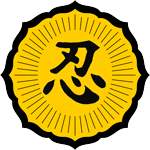KOKUSAI BUTOKUKAI | The Badge Of Our Federation
The badge that we use has different meanings for different people within our organization. But all meanings of the badge have one common denominator, O’Sensei Richard Kim.
The Kanji is Japanese for “Patience”. O’Sensei Richard Kim originally drew this particular kanji. One of O’Sensei Richard Kim favorite quotes was, “Patience is the ballast of the soul”. We use this philosophy as a corner stone of our organization.
The fifty-four rays represent one half of one hundred and eight, which is the number of vices or impurities in the Buddhist world. O'Sensei Richard Kim embraced the Buddhist philosophy and was a practicing Shingon Buddhist priest. Traditionally the number of kata's within a system of karate was often 54. An example of the importance placed on the number can be found in the kata Gojushiho, or "fifty four” which is still practiced within the Shorinji Ryu Karate style and other Okinawa styles of karate.
We of the Kokusai Butokukai embrace O'Sensei Richard Kim's philosophy that learning many traditional kata's expands the martial artists ability to speak and understand the language of the martial arts.
The following was written by one of O’Sensei senior instructors Neville Billormia with some editing by Rod Sanford:
In the 1830´s Matsumura developed a 54 kata system in the Shorin styles of Shuri-Te Karate. The system of 54 kata in a style is an ideal no longer rigidly held to and rarely reached in this day and age.
Today not all styles have 54 kata It may be that the heads of particular systems quit their instructor (Master) before learning all 54 kata. Or the master may have died before passing on all 54 kata to his followers. In other cases the master of the system may have refused to teach or pass on the entire system of all 54 kata to his followers. This may be because the master felt the students did not meet criteria the master had set. For example, Master Gichin Funakoshi only passed on 16 kata in Japan although he knew at least 54 kata and probably more. But for whatever the reason, today not many schools in the United States adhere to the 54-kata systems. And so you find many systems teaching much fewer katas, sometimes only 7 to 20 kata.
Just because a system teaches fewer than 54 kata does not mean that the system is not legitimate. You will find most Shito-Ryu styles with about 36 kata, most Shotokan styles with about 20 kata, most Goju-Ryu systems with 18 kata and most Wado-Ryu with 10 kata. Other systems, such as our system, have expanded on the 54-kata systems. There are many reasons for doing this. A poor excuse for expanding on the 54-kata systems would be following the line of thinking that, "More is better.” O’Sensei Richard Kim, master of our system often said that, “Quality is better than quantity.” Then why did he teach more than 54 empty-hand kata? O’Sensei Kim taught more than 54 kata to his senior students (or veteran instructors) to increase their knowledge of Traditional Karate. For example, in our system O’Sensei Kim passed on three versions of Patsai Dai, two versions of Patsai Sho along with the Matsumura and Oyadomari Patsai kata The average student was not expected to learn all the variations of the kata. But veteran instructors were, thus increasing their depth of knowledge of the art. If you look at our list of over 80 empty hand kata and deduct the pinan katas and variations of the same kata you will find that although you will have more than 54 kata you are coming close to a 54 kata system.
But why 54?
A very brief and simple answer is 54 times 2 equals 108. 108 is a number associated with purity and perfection in the orient. On New Year's Eve the gongs of the temple are rung 108 times. Each time is to cleanse the old year of one of its defilements and to celebrate the New Year's clean and fresh start. One hundred eight is a symbol of perfection, totality, and circularity. (Please note that Yang style Tai Chi as we practice it has 108 movements for the same reason.)
54 is half of 108. Traditionally there are 54 shrines in a Buddhist temple. Each shrine has a significance. Each kata in a 54 kata system also has a significance. The martial artist views his kata system with the same reverence that a Buddhist views his shrines.Thus it only make sense to have 54 kata in the system, as there are 54 shrines in a Buddhist temple.
Most systems with 54 katas also have a kata named Gojushiho or Useishi (54 steps). The number 54 is used by the kata because the number has significance. Numbers have significance within the Book of Changes (I-Ching) and other Chinese Classics. And most old masters, including O'Sensei Kim were very much into the Chinese Classics.
And most old masters, including O'Sensei Kim were very much into the Chinese Classics. The use of math and thus numbers within the Martial Arts such as Pau Kua and of course the Chin-variation of the Yang form are significant and meaningful for those of us who trained with O'Sensei.
We used this crest until after O'Sensei's death in 2001. Since we no longer held an affiliation with the old Japanese organization we decided we would drop the use of the 108 lines to differentiate our crest. Thus we adopted the 54 lines (Half of 108) which has a greater significance to the primary art, Shorinji-Ryu Karate, that was passed on to us by O'Sensei Richard Kim.




